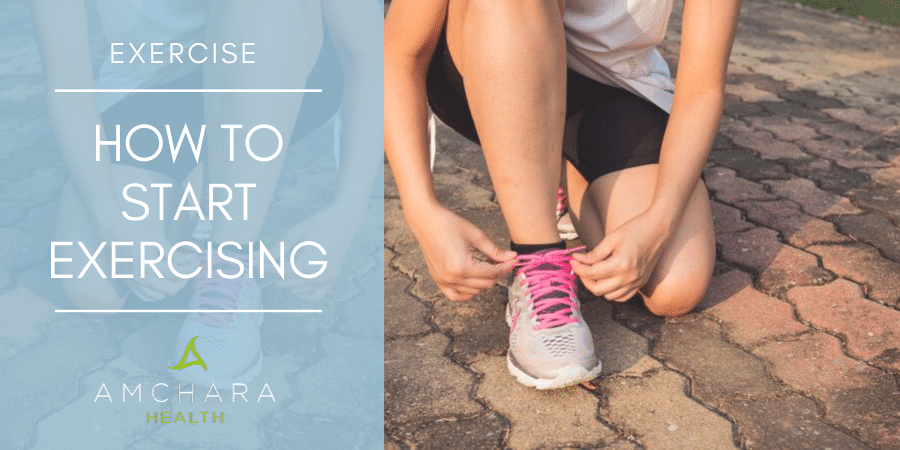Topics Covered in this article:
The evidence is clear – a sedentary lifestyle is linked to a whole host of chronic health conditions and regular exercise brings many benefits to health.
These range from stress relief and improvements to mood patterns (1) and also to enhanced cardiovascular (2) and respiratory health.
Exercise is even known to boost brain function (3).
No one can deny that exercise is good for you, but it can be a struggle to actually get started or incorporate regular exercise sessions.
In this article we take a look at some simple and effective ways to begin.
1. Ask yourself WHY
Motivation to exercise comes from within and despite people telling you that you should be doing more exercise (even if it is a healthcare provider) you may still struggle to get going.
Really ask yourself ‘Why exactly do I want to start exercising?’.
A common reason is to lose weight, if so, try to be even more specific and note down how much weight, or which clothes size you’re aiming for.
If improving your health is your motivator, ask yourself which aspect of health is important to you – cardiovascular, muscular, joint or mental health?
Be precise and note the exact symptoms you want to eradicate.
Take note of your reasons and any goals and write them down.
Regularly reviewing these is a great way to maintain motivation.
Pin up your reasons on the bathroom mirror, fridge or noticeboard – anywhere that you will regularly see them.
Go one step further and say your reasons out loud first thing in the morning; this cements it in your mind and supports motivation.
2. Be realistic
Aiming too high is only going to increase the chances of giving in too early or failing in reaching your goals.
For example, it is unreasonable to expect to be able to run a marathon in the first three months of starting exercise.
Having a good mental picture of what you are likely to be able to achieve to start with increases motivation.
Being realistic as you progress with intensity and duration of exercise prevents disappointment that you may not be able to do as much as you had first thought.
Try not to underestimate your abilities though – you don’t want it to be too easy.
3. Assess your fitness level
Whether you are a complete newcomer to exercise or you are returning after a break or injury, it is advisable to have your fitness level assessed.
If you have a medical condition, are on medication or have recovered from an illness or injury your doctor will be able to guide you on whether it is okay to start exercising.
Personal trainers can put you through your paces and can assess your specific fitness levels.
4. Design your programme
Taking a casual approach and thinking you can ‘squeeze’ in a walk or a run one or two days a week may not be the best motivation.
Take some time to sit down and plan out a six week programme to start with.
Realistically assign a set period of time per day or week for exercise.
Factor in which type of exercise best suits your needs – walking, running, swimming, cycling etc. and plan how long each session will take and maybe also map out your route.
It has to be said that you do not need to join a gym or fitness centre to take part in exercise.
It can be done at home, outdoors in the park or on the seafront.
Specialised equipment is not always required – don’t let cost put you off starting a new exercise regime.
Don’t forget to add in a warm up and a cool down for each session – these are vital for preparing the mind and the body for exercise and for preventing injury.
Current UK government recommendations are to be active daily and to take part in moderately intense exercise for 30 minutes at least five days a week.
Higher intensity exercise requires less time to achieve similar benefits and high intensity interval training (HIIT) is popular, especially if time is an issue.
Take it slowly and over the six week plan gradually increase the duration, frequency and intensity of the exercise.
It could be that the first week is spent walking, with an increase in speed or distance by the second week. In the third week a small jog could be incorporated and by the end of week six you could add in short runs.
Make sure you do some resistance exercise, either using weights or your own body resistance.
This type of exercise not only supports muscle mass but is vital for building bones (4).
Once your six week plan is coming to an end, sit down and plan the next six weeks – revisit your reason for exercising and any goals and ensure your plan meets these.
5. Find an exercise buddy
Make exercise a social activity and not an isolated activity.
Chances are there will be someone you know in a similar situation and although they may have their own specific reasons and goals, they may be more than happy to exercise alongside you.
Working out with a friend or colleague can drastically improve motivation (and the chance that you will actually leave the house).
6. Listen to your body – NOT your mind
Starting anything new is hard and there may be issues that you need to overcome in order to succeed.
Your body will tell you if you have overdone it.
Don’t be led by the ‘no pain, no gain’ phrase – yes, a degree of overload is required to make improvements and progress, but if you push yourself too hard you will lose enjoyment and potentially injure yourself.
If you feel uncomfortable, breathless or lightheaded then STOP and rest and then start again at a reduced intensity.
Don’t fall for the many tricks of the mind – there may be a vast amount of ‘reasons’ why your mind is telling you shouldn’t do any exercise.
One of the easiest ways to overcome this is to just get on with it!
Keep your goal in mind and remind yourself WHY you are exercising.
Once you are off and taking part in your exercise you may also need to ignore the ‘reasons’ why your mind is trying to persuade you to give up mid-workout.
Be strong!
7. A healthy habit
Exercise should not be a chore or an activity that has to be shoehorned into your day.
Exercise should be a normal part of your routine and the more you do, the more it becomes a habit.
On average it takes around 21 days to form a habit, so your six week plan will take you beyond this and by the end of the first plan you should be well on your way to making exercise a healthy habit.
There may be days when you are unable to take part in your set exercise session, don’t be disheartened and let the routine slide, simply start again at the next available opportunity.
You may find that you miss your normal session if you can’t fit it in.
Taking the first step to starting a new exercise regime can feel daunting and your mind may be trying to persuade you otherwise, but with so many health benefits associated with regular physical activity there are many reasons to make it part of your normal routine.
If you have health concerns or would like to know more on how you can achieve optimal health, then a one-to-one consultation with a Personalised Health practitioner can give you guidance and a personalised programme to meet your specific needs.
We hope you enjoyed this article.
Do you have any top tips on how to get active?
Do you have any other suggestions that have helped you?
We’d love to hear your thoughts.
Read this next:




